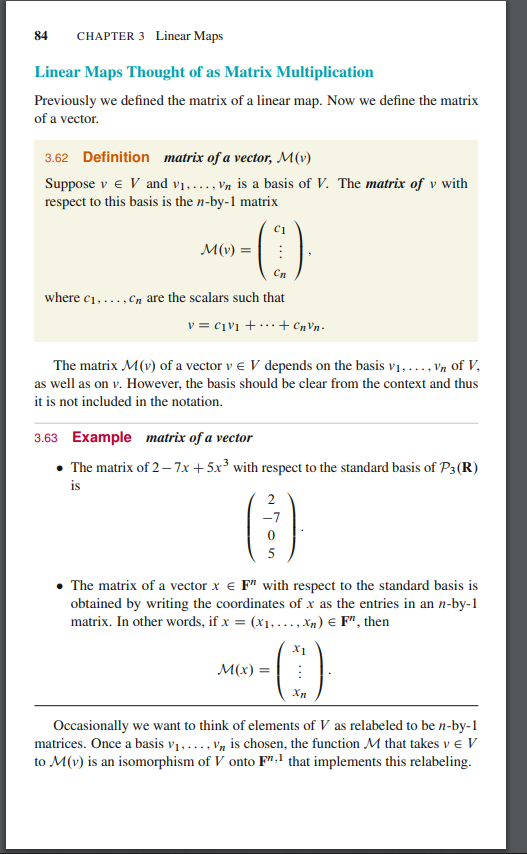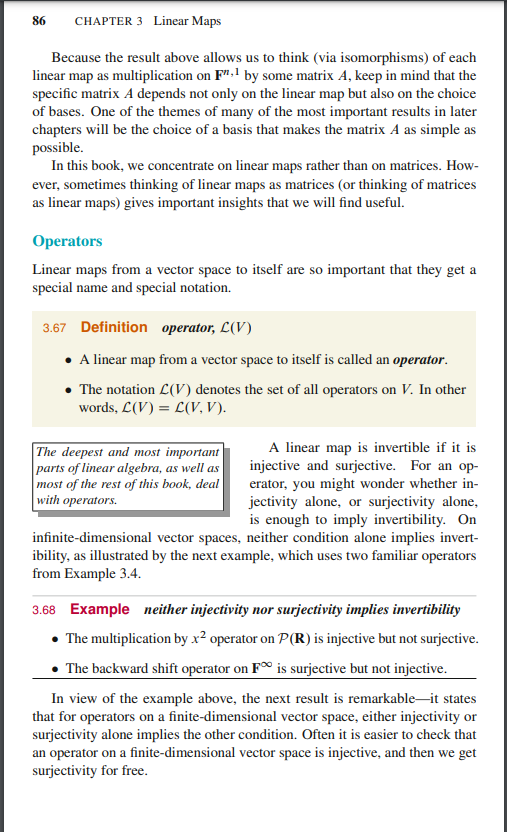Suppose V and W are finite-dimensional. Then L.V; W / is finitedimensional and dimL(V,W) = D (dim V)( dim W)
Suppose V and W are finite-dimensional. Then L.V; W / is finitedimensional and dimL(V,W) = D (dim V)( dim W)
Elementary Linear Algebra (MindTap Course List)
8th Edition
ISBN:9781305658004
Author:Ron Larson
Publisher:Ron Larson
Chapter7: Eigenvalues And Eigenvectors
Section7.2: Diagonalization
Problem 45E
Related questions
Question
Given
Suppose V and W are finite-dimensional. Then L.V; W / is finitedimensional and
dimL(V,W) = D (dim V)( dim W)

Transcribed Image Text:84
CHAPTER 3 Linear Maps
Linear Maps Thought of as Matrix Multiplication
Previously we defined the matrix of a linear map. Now we define the matrix
of a vector.
3.62 Definition matrix of a vector, M(v)
Suppose v e V and v1,... Vn is a basis of V. The matrix of v with
respect to this basis is the n-by-1 matrix
M(v) =
Cn
where c1,..,Cn are the scalars such that
v = c1V1 +.+ CnVn-
The matrix M(v) of a vector v e V depends on the basis v1,.., Vn of V,
as well as on v. However, the basis should be clear from the context and thus
it is not included in the notation.
3.63 Example matrix of a vector
• The matrix of 2– 7x +5x³ with respect to the standard basis of P3(R)
is
()
2
-7
5
• The matrix of a vector x e F" with respect to the standard basis is
obtained by writing the coordinates of x as the entries in an n-by-1
matrix. In other words, if x = (x1,..., Xn) € F", then
()
X1
M(x) =
Xn
Occasionally we want to think of elements of V as relabeled to be n-by-1
matrices. Once a basis v1,..., Vn is chosen, the function M that takes v e V
to M(v) is an isomorphism of V onto F",1 that implements this relabeling.

Transcribed Image Text:86
CHAPTER 3 Linear Maps
Because the result above allows us to think (via isomorphisms) of each
linear map as multiplication on F".1 by some matrix A, keep in mind that the
specific matrix A depends not only on the linear map but also on the choice
of bases. One of the themes of many of the most important results in later
chapters will be the choice of a basis that makes the matrix A as simple as
possible.
In this book, we concentrate on linear maps rather than on matrices. How-
ever, sometimes thinking of linear maps as matrices (or thinking of matrices
as linear maps) gives important insights that we will find useful.
Operators
Linear maps from a vector space to itself are so important that they get a
special name and special notation.
3.67 Definition operator, L(V)
A linear map from a vector space to itself is called an operator.
The notation L(V) denotes the set of all operators on V. In other
words, L(V) = L(V, V).
The deepest and most important
parts of linear algebra, as well as
most of the rest of this book, deal
with operators.
A linear map is invertible if it is
injective and surjective. For an op-
erator, you might wonder whether in-
jectivity alone, or surjectivity alone,
is enough to imply invertibility. On
infinite-dimensional vector spaces, neither condition alone implies invert-
ibility, as illustrated by the next example, which uses two familiar operators
from Example 3.4.
3.68 Example neither injectivity nor surjectivity implies invertibility
• The multiplication by x² operator on P(R) is injective but not surjective.
The backward shift operator on F is surjective but not injective.
In view of the example above, the next result is remarkable-it states
that for operators on a finite-dimensional vector space, either injectivity or
surjectivity alone implies the other condition. Often it is easier to check that
an operator on a finite-dimensional vector space is injective, and then we get
surjectivity for free.
Expert Solution
This question has been solved!
Explore an expertly crafted, step-by-step solution for a thorough understanding of key concepts.
This is a popular solution!
Trending now
This is a popular solution!
Step by step
Solved in 4 steps with 4 images

Recommended textbooks for you

Elementary Linear Algebra (MindTap Course List)
Algebra
ISBN:
9781305658004
Author:
Ron Larson
Publisher:
Cengage Learning

Linear Algebra: A Modern Introduction
Algebra
ISBN:
9781285463247
Author:
David Poole
Publisher:
Cengage Learning

Algebra & Trigonometry with Analytic Geometry
Algebra
ISBN:
9781133382119
Author:
Swokowski
Publisher:
Cengage

Elementary Linear Algebra (MindTap Course List)
Algebra
ISBN:
9781305658004
Author:
Ron Larson
Publisher:
Cengage Learning

Linear Algebra: A Modern Introduction
Algebra
ISBN:
9781285463247
Author:
David Poole
Publisher:
Cengage Learning

Algebra & Trigonometry with Analytic Geometry
Algebra
ISBN:
9781133382119
Author:
Swokowski
Publisher:
Cengage

Elements Of Modern Algebra
Algebra
ISBN:
9781285463230
Author:
Gilbert, Linda, Jimmie
Publisher:
Cengage Learning,
